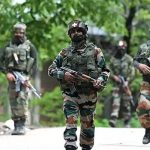Originally publishedt at: https://www.eurasiareview.com/02052025-pakistans-hollow-posturing-desperate-contradictions-expose-a-nation-in-panic-oped/
As tensions mount between India and Pakistan following the Pahalgam terror attack, Pakistan’s response has been a jarring symphony of contradictions, exposing deep fissures within its establishment and revealing a nation desperate to avoid confrontation while simultaneously beating the drums of war.
Pakistan’s leadership has veered from nuclear threats to peace overtures, from denying terrorism links to admitting them, and from projecting military strength to revealing embarrassing operational weaknesses – all within a matter of days.
Confessions and Contradictions: Pakistan’s Terror Admission
In what can only be described as a stunning diplomatic self-goal, Pakistan’s Defence Minister Khawaja Muhammad Asif openly admitted on international television that his country has been supporting, training, and funding terrorist organizations for three decades. When directly questioned by a Sky News journalist about Pakistan’s history of backing terror outfits, Asif responded with a candid confession: “We have been doing this dirty work for the United States for about 3 decades… and the west, including Britain.”
This extraordinary admission came just days after the horrific Pahalgam attack that claimed 26 innocent lives, mostly tourists visiting Kashmir. Asif awkwardly attempted to deflect blame onto Western nations, describing Pakistan’s support for terrorism as a “mistake” for which the country has “suffered.” He further claimed that Pakistan’s international reputation would have remained “unimpeachable” had it not aligned with Western powers during the Soviet-Afghan war and following the 9/11 attacks.
The confession has severely undermined Pakistan’s longstanding denial of state sponsorship of terrorism and validates what India has maintained for decades. At the United Nations, India’s Deputy Permanent Representative, Ambassador Yojna Patel, seized upon Asif’s comments, stating that “this open confession surprises no one and exposes Pakistan as a rogue state fuelling global terrorism and destabilising the region.”
The Fabricated Front Line: Gen Asim Munir’s “Visit” Deception
Even as Pakistan desperately tries to project military readiness, its propaganda machinery has resorted to recycling old footage. A video widely circulated on social media purportedly showing Pakistan’s Army Chief General Asim Munir visiting the Line of Control (LoC) to inspect “operational readiness” amid rising tensions has been conclusively proven false. Fact-checking revealed that the footage actually dates back to December 2022, shortly after Munir assumed command of Pakistan’s armed forces. Multiple reportings, including in Pakistani media outlet Dawn, confirm that the video shows Munir’s visit to frontline troops in the Rakhchikri Sector over two years ago. The deliberate misrepresentation of old footage as current appears to be a calculated attempt to reassure Pakistan’s domestic audience while projecting strength to India – a facade that crumbled under basic scrutiny.
Digital Delusions: Pakistan Air Force’s Embarrassing Visual Blunders
In perhaps the most embarrassing display of Pakistan’s desperate attempts to inflate its military capabilities, the Pakistan Air Force (PAF) released a propaganda video on April 29 that inadvertently showcased foreign military hardware as its own. The official video, published by the Directorate General of Public Relations of the PAF, titled “Pakistan Air Force Reaffirms Unwavering Commitment to National Sovereignty & Defence Excellence,” became an international laughingstock within hours.
Indian analysts and social media users quickly identified glaring errors in the supposed display of Pakistan’s military might. Incredibly, the video included footage of Russia’s S-400 air defense system, a sophisticated platform operated by India but not Pakistan – alongside imagery of SpaceX’s Falcon 9 rocket, an American commercial launch vehicle with absolutely no connection to Pakistan’s military.
“PAF showcasing Indian S-400s in their defence video. We accept your admiration,” mocked one Indian social media user, while another commented, “PAF now has Falcon 9? Elon Musk must be surprised!” The incident has not only subjected Pakistan to ridicule but has also exposed the profound insecurity and technological limitations of its armed forces.
Nuclear Posturing: The Last Refuge of the Desperate
Facing India’s resolute stance following the Pahalgam attack, Pakistan has predictably resorted to nuclear sabre-rattling. Defence Minister Khawaja Asif warned of using nuclear weapons “if there is a direct threat to our existence,” while Railway Minister Hanif Abbasi menacingly claimed that Pakistan’s arsenal of “Ghori, Shaheen and Ghaznavi missiles along with 130 nuclear warheads” has been kept “only for India.”
This reckless invocation of nuclear threats stands in stark contrast to India’s responsible nuclear doctrine, which includes a firm commitment to “no-first-use.” Pakistan’s nuclear posturing appears increasingly desperate, aimed less at deterrence and more at attracting international attention and intervention.
Military experts analysing the situation have dismissed Pakistan’s nuclear threats as hollow. On an India Today broadcast, Lieutenant General Satish Da, former chief of integrated defense staff, observed: “Pakistan has been playing the nuclear card for too long… Pakistan knows that it is no match for India in conventional terms both qualitatively and quantitatively and in fact that is why it has waged this death by thousand cuts policy proxy war.”5
The Panic Button: Fears of Indian Retaliation
The contradictions in Pakistan’s messaging reached a fever pitch when, in the early hours of Wednesday, Pakistan’s Information Minister Ata Tar published a video claiming “credible intelligence” that India intended to carry out military action against Pakistan within “24 to 36 hours. “This dramatic midnight announcement betrayed Pakistan’s mounting anxiety about potential Indian retaliation for the Pahalgam attack.
Even as Pakistan’s military establishment projects confidence, the civilian leadership appears to be preparing the ground for international intervention. Prime Minister Shehbaz Sharif has called for a “neutral, transparent and credible investigation” into the Pahalgam attack, a proposal that was quickly endorsed by China in what appears to be a coordinated diplomatic manoeuvre to prevent Indian military action.
Sharif’s plea for international involvement stands in stark contrast to his simultaneous warning that “nobody should remain under any false pretence. Our armed forces are fully capable and prepared to defend the country against any misadventure.” The cognitive dissonance in these statements reveals a nation desperately trying to avoid confrontation while saving face domestically.
A House Divided: Pakistan’s Incoherent Messaging
The disparate voices emerging from Pakistan’s establishment reveal a nation without a cohesive strategy. While the Defence Minister admits to decades of terrorism support, the Prime Minister insists that “Pakistan has always condemned terrorism in all its forms and manifestations.” While military commanders threaten retaliation, civilian leaders seek international mediation.
This cacophony of conflicting messages reveals a profound disconnect between Pakistan’s civilian government, military establishment, and intelligence apparatus – each pursuing different priorities and speaking to different audiences.
Last Word
As India maintains a measured yet firm stance following the Pahalgam attack, Pakistan’s frantic posturing and contradictory messaging expose a nation painfully aware of its military disadvantages. The recycling of old footage, embarrassing propaganda blunders, desperate nuclear threats, and contradictory statements paint a picture of a state in disarray.
Pakistan’s conventional military inferiority is stark. As noted by Commodore Anil J Singh, “We’ve got 16 subs, they’ve got three, so that’s a sort of asymmetry between our two naval forces.” This disparity extends across all military domains, leaving Pakistan with few options beyond nuclear threats and appeals for international intervention.
As tensions continue to simmer, Pakistan’s leadership must reckon with the consequences of its decades-long support for terrorism and the unsustainability of its current posture. No amount of chest-thumping, manufactured imagery, or nuclear threats can disguise the fundamental weakness of a nation caught in its own contradictions.













